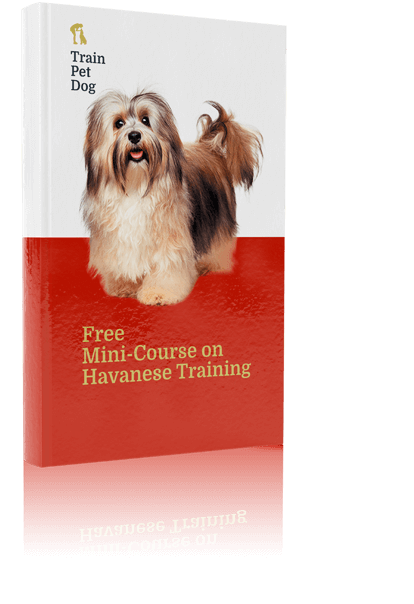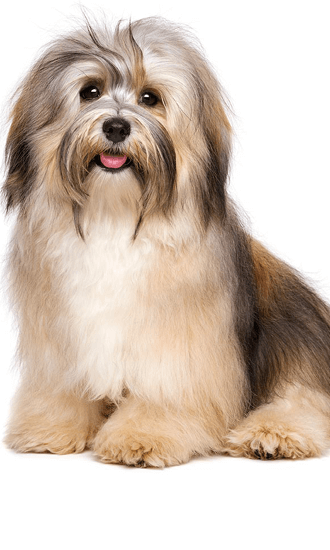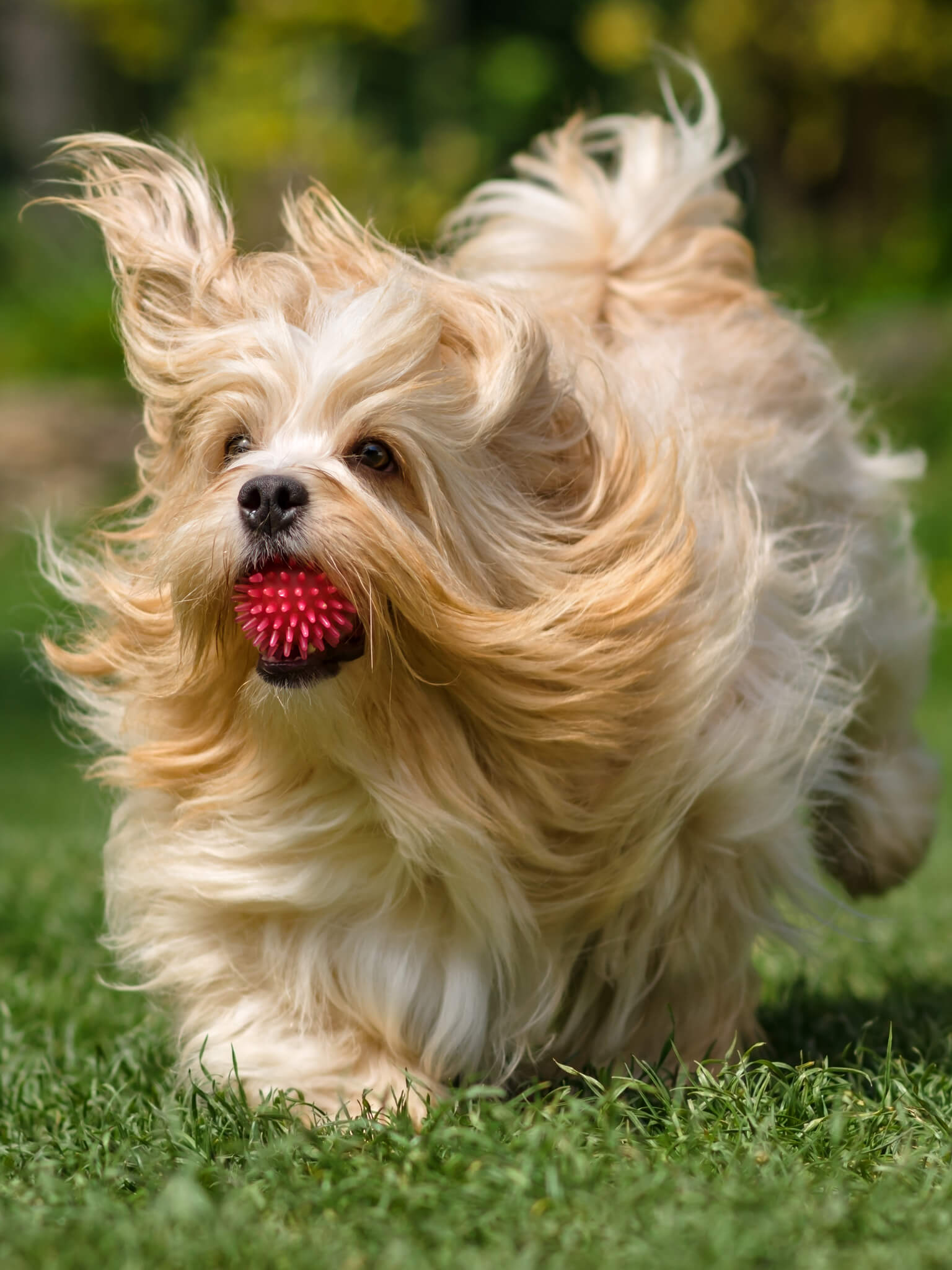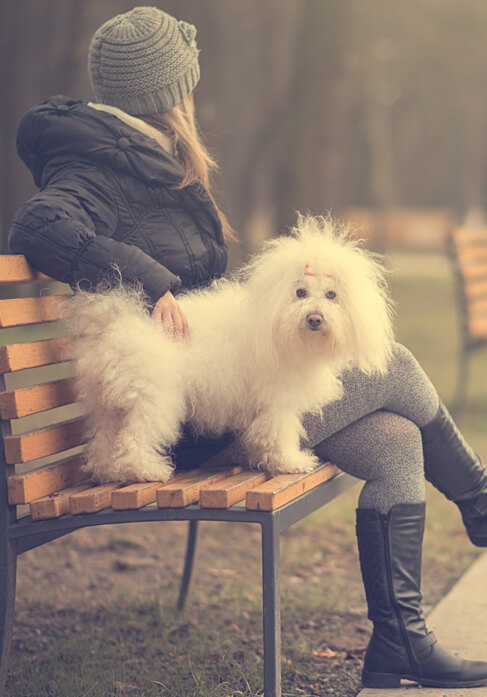Privacy Policy: Your email address is 100% safe.
We don't spam and hate it as much as you do :-) You can also unsubscribe from our mailing list at any time.

Sign Up
Havanese: Breed Personality, Fitness & Care

Country of Origin, History of Havaneses
The Havanese descends from the same ancestor as the entire Bichon family, the Tenerife. The dog's journey to Cuba most likely was aboard the trade ships sailing from the island of Tenerife in the early sixteenth century.
Bichon Lapdogs were being brought to Cuba in 17th century from Europe, where they adapted to the climate and the customs of Cuba. Eventually, these conditions gave birth to a different dog, smaller than its predecessors, with a completely white coat of a silkier texture. The Bichon Havanese originated in the 19th century (1800-1900). By the mid-1800s the Havanese was so popular that it was owned by such celebrities as Queen Victoria and Charles Dickens. It became known as the dog of the aristocratic class of sugar barons of Cuba.
The Havanese was continually bred in Cuba all through the 20th century (1900-2000) and was the preferred pet/dog of the Cuban families. With the advent of the Cuban revolution in the late 1960s and early 1970s, the class of Cubans who owned Havanese was the first to leave. Breeding the Havanese in the USA started in the 1970s. Remarkably, through all their travels, Havanese type and purpose has remained virtually unchanged for the past hundred and fifty years.
The duties of the Havanese traditionally have been those of companion, watchdog, child's playmate and herder of the family poultry flock.
The breed known as Havenese is the National Dog of Cuba and the only native breed to that country.
Havanese Tools
Breed Selector Tool - is the Havanese the right breed for you?
Is the Havanese the right breed for you and your family?
Find out by using our Free Dog Breed Selector Tool
Check Your Havanese's Learning Style
Are you aware dogs also have a learning style that can greatly affect their ability to housetrain as well as be trained correctly. Evaluate your Havanese's learning style and personality using our free Learning Style tool so that you are better able to provide him with the proper Havanese training methods.
Is your Havanese dominating over you?
Does your Havanese bark unnecessarily? Does your Havanese come to you when you call? Download a FREE Report on Dog Dominance for you and your Havanese and learn how to control your dog.
Do you make these mistakes with your Havanese?
Are you inadvertently snow-balling bad behavior in your Havanese? Evaluate your Dog Training Style from our Free Tool and learn how best to deal with your dog.
Havanese Calorie Calculator
Do you know how many calories your Havanese needs every day and how many cups of food you should be giving it every day? Click here to use our Havanese Calorie Calculator.

A General Appearance of the Dog
The Havanese breed is a deceptively light and frivolous looking dog that is assuredly sound of mind and agile in movement. Its long, fluffy coat gives no indication of the “trooper” in this tried and true companion.
The breed is longer in leg than its cousin the Bichon and less dense in coat.
The Havanese’s expression is soft and intelligent, mischievous rather than cute. The eyes are dark brown, large, almond-shaped, and set rather widely apart. Ears are of medium length with long hair and hang down.
The Havanese has a long tail that is covered with long silky hair. The profuse coat varies from wavy to curly. The Havanese is a double-coated breed with soft hair, both on outer and undercoat. Adult coat reaches 6 to 8 inches, and has a pearly sheen.
Coat Color
The Havanese comes in an array of colors that include black, silver, cream, champagne, tan, blue, chocolate, fawn, gold and white.
All colors are acceptable, singly or in any combination and may be brindled, with the exception of white. No preference is given to one color over another. The skin may be freckled or parti-colored.
Coat Type
The Havenese coat is unique and reflects centuries of living in the tropics. It consists of a double coat that may reach 6-8” in length and is remarkably soft and light in texture. While it appears dense, the coat is actually a profusion of raw silk-like floss that has an insulating, protective quality against the harsh tropical sun. The coat of the Havanese should never be rough or wooly. Their coat may be straight, wavy or even curly, but usually is a result of a mix of one or more textures.
Height
Males: 9-10 inches
Females: 8-9 inches
Weight
Males: 9-11 lbs.
Females: 7-10 lbs.



Free Havanese Training Secrets
Free Course on Havanese Training & Obedience
Stop All Bad Behavior, Excessive Barking and Biting
Havanese Personality Traits

Temperament of the Dog
Havanese are very sociable and happy dogs who are easy to obedience train. This makes then good, portable traveling companions as they are quite adaptable. Long absences from family are not tolerated by the Havanese breed so should be considered when choosing one as a pet.
They do best in pairs or at least with other another canine in the family. Havanese get along well with other family pets.
This clever little acrobat was known as the “circus dog “for many years because of its ability to quickly learn and execute tricks.
Anxious to please, Havanese is a lively, loving breed that adores children and adults alike. Havanese are natural companion dogs: gentle and responsive, with a high degree of intelligence.
Because of their good nature they will not make much of a protective watchdog, but will alert you to strangers. Barking is one of their fondest pastimes so they should be taught early to quit barking on command so that their barking does not become a nuisance.
This curious dog loves to sit up high on a chair to observe what is going on. It is very sensitive to the tone of your voice. Harsh words will only upset the dog and will achieve very little.
Better suited to an indoor or outdoor lifestyle?
Great for apartment living, Havanese will usually find indoor play plenty of exercise and when finished locate a seat by a window to observe the outside.
Since they are so social, a walk on lead with opportunity to meet others will never be dismissed.
The Havanese is a breed meant to live in your home, and never outside or in a kennel.
Are they suited to homes with kids?
Families with children were made for the Havanese. Their extreme need for companionship and closeness are in complete harmony with children's play and cuddle time.
Havanese Activity Level
How Active is the Breed?
The playful Havanese dog has a high demand for mental exercise and play but an average demand for exercise. Tricks and toy play will keep this dynamo satisfied indoors, but a regular walk on lead or yard play will futher exercise and socialize this happy pet.
How Much Exercise Does the Dog Need at every stage of its Life?
Keeping the Havanese mentally active is a life-long goal any owner should want to achieve. He will never tire of trying new things for you and his high intelligence will be better tested doing things you wish rather than left to his own destructive devisees.
Havanese puppies benefit from early obedience training on a lead. Once this is established, daily walks or yard play will be enough to keep your Havanese exercised and healthy.
Grooming
The look of the Havanese is natural and unkempt; however this is not achieved by neglect.
The soft, double coat of the Havanese will require frequent care and should be considered when choosing this breed. Daily brushing of the coat is necessary if it is to be kept long. While brushing always look for any small mats forming. A trip outdoors for a morning duty in wet grass can be just the situation for mats to start.
Many pet owners opt to have their Havanese professionally groomed 3-4 times a year and kept in a short, easily maintained cut.
Nails should be clipped regularly and eyes should be kept free from hair. The feet also may need to be trimmed neatly.
This breed is great for those with allergies and does not shed. Some divisions of the breed are said to be hypo-allergenic but check with your breeder to see which one is best suited to your needs.


Free Havanese Training Secrets
Free Course on Havanese Training & Obedience
Stop All Bad Behavior, Excessive Barking and Biting
Health and Care
Genetic Problems
The Havanese is a very healthy long-lived breed however; some are prone to cataracts, luxating patellas, poodle eye and dry skin.
With proper breeding by a reputable breeder, you should eliminate or reduce any of these inherent problems.
Breeding the Dog and any Cautions
Havanese have no serious issues concerning breeding but only your breeder should be consulted when choosing a proper mate for your pet.
Litter Size: Average litter 4 puppies
Life Span: 14-15 years.
National Breed Clubs
National Breed Clubs
British – The Havanese Club of Great Britain – www.havaneseclub.co.uk, US – Havanese Club of America - www.havanese.org/
Other Recognition: CKC, FCI, AKC, UKC, KCGB, NKC, CKC, ANKC, APRI, ACR
Only those Havanese registered with the Original Havanese Club (OHC) may be registered with the UKC. The Havanese is also recognized by the American Rare Breed Association.
Rescue Link: www.havanese.org/hcaRescue.htm
Group: Toy Group
AKC Popularity Ranking: 24
Also Known As: Bichon Havanais, Havana Silk Dog, Spanish Silk Poodle, “Circus Dog”.
Train Your Havanese To Listen To You
Get Instant Access to Your Training Now - For Free
Sign up for our Free Havanese Mini Course to have a housebroken, obedient dog that happily comes to you every time you call.
You'll learn new commands to obedience-train your dog as well as how to housebreak your dog in 6 days or less.
You'll also learn how to eliminate bad habits like barking, nipping or biting, jumping, or pulling on the leash.Here's just s small fraction of what else you'll learn in the course:
How to lead and think like a pack dog - the new psychology.
3 dangerous mistakes that most Havanese owners make when they are trying to potty train their dogs.
The 2 main reasons why your dog barks excessively and how to control its excessive barking.
How to obedience train your Havanese to permanently end behavioral problems like Jumping, Aggression, Pulling on Leash.
A surprisingly easy way to teach your dog cool new tricks.
How to improve your dog's lifespan and keep it from getting overly heavy with a healthy and nutritious diet.
Getting Pro help fast - how to get access to our expert trainers when you need them most.
One hidden psychological trigger that all Havaneses have... that practically allows you to "analyze" and "control" your dog's every action.
Priority access to the free online seminars conducted by our training experts.
Whereas other dog training related web sites and books offer generic information for dogs in general, ours is the ONLY web site that offers Havanese information specifically, from a renowned panel of experts - because as you probably know, Havaneses have their own special training requirements that other dogs don't have.
Our Dog Experts
The Havanese training information you will read here was developed by a panel of renowned dog training experts whose combined wisdom represents nearly 100 years of specialist experience training dogs.
Here are a few of our experts:




